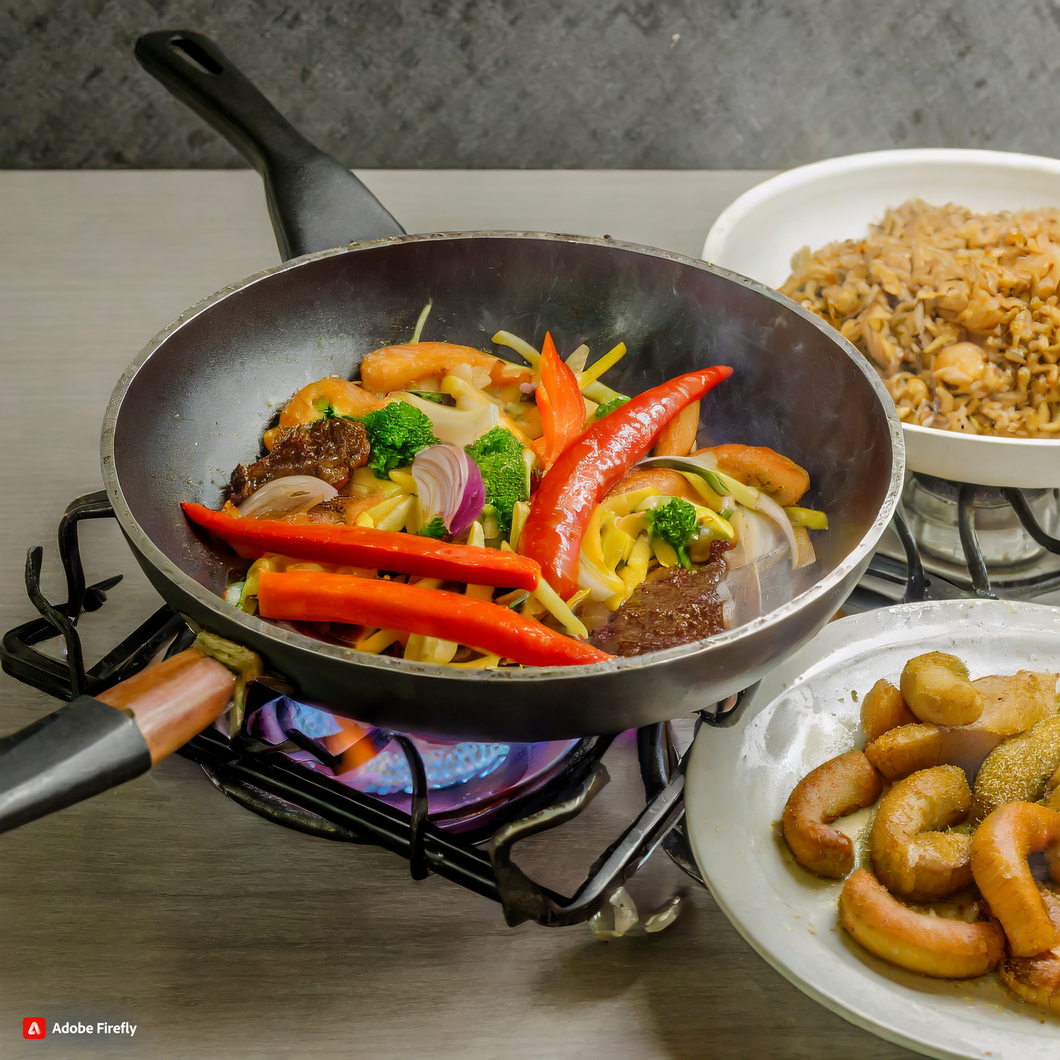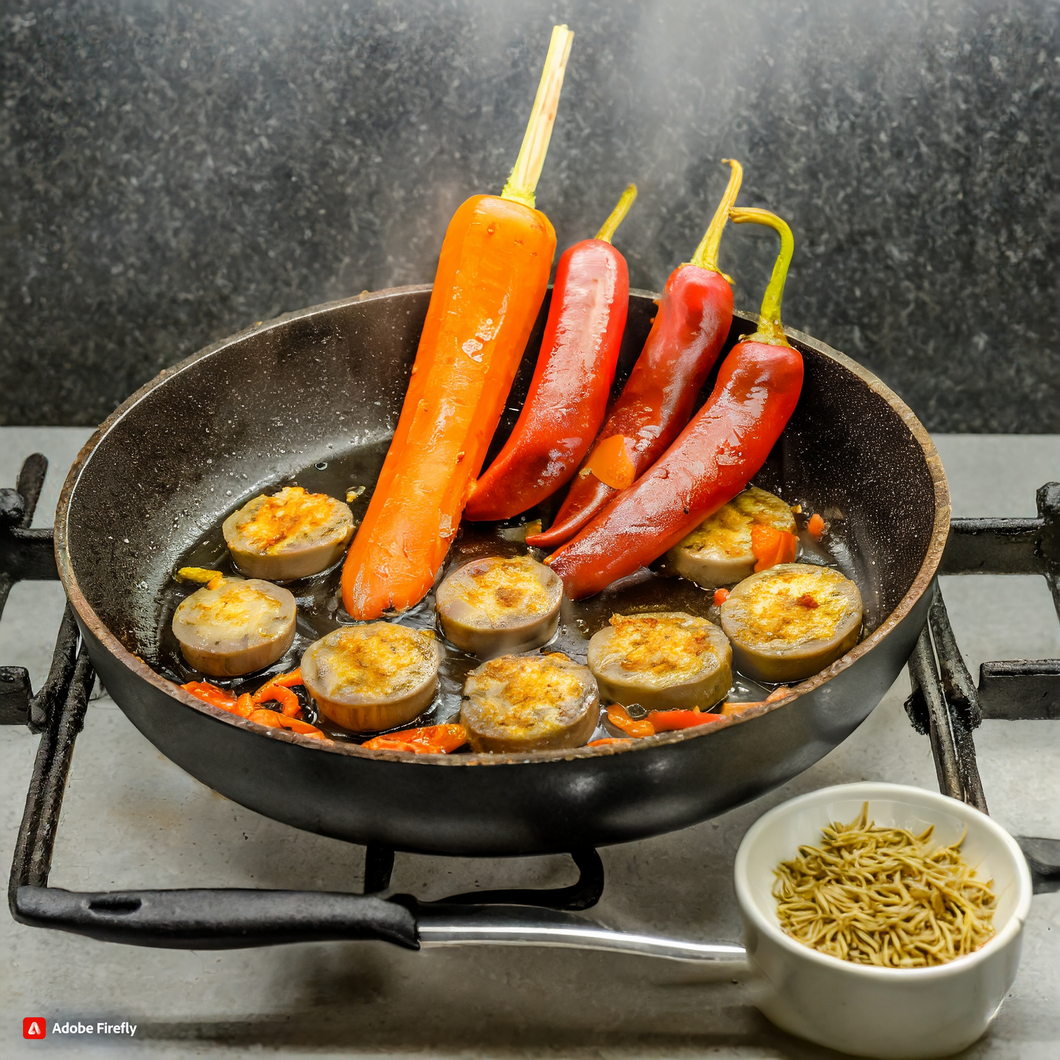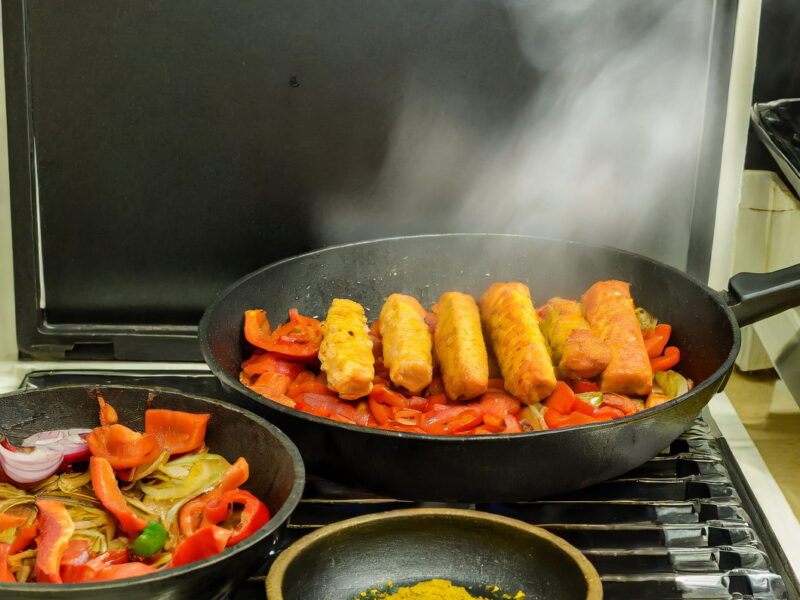Introduction
Sautéing and frying are two popular cooking methods that involve cooking food in hot oil or fat. While they may seem similar, there are some key differences between the two techniques. In this article, we will explore the differences between sautéing and frying and how they affect the taste and texture of the food being cooked.
Sautéing vs. Frying: Understanding the Basic Techniques
Have you ever wondered what the difference is between sautéing and frying? These two cooking techniques may seem similar, but they actually have distinct differences that can greatly affect the outcome of your dish. In this article, we will break down the basics of sautéing and frying, and help you understand when to use each technique for the best results.
First, let’s start with sautéing. This cooking method involves cooking food quickly in a small amount of fat over high heat. The word “sauté” actually comes from the French word “sauter” which means “to jump”. This is because when you sauté, you are constantly moving the food around in the pan, causing it to jump and cook evenly.

Sautéing is typically done in a skillet or sauté pan, which has a wide, flat bottom and low sides. This allows for maximum surface area for the food to come in contact with the heat. The fat used for sautéing can vary, but it is usually a combination of oil and butter. The high heat and small amount of fat used in sautéing allows for the food to cook quickly and evenly, while also developing a nice golden brown color and crispy texture.
On the other hand, frying involves cooking food in a larger amount of fat over medium to high heat. Unlike sautéing, the food is not constantly moved around in the pan. Instead, it is left to cook and develop a crispy exterior while remaining tender on the inside. Frying is typically done in a deep pot or pan, with enough oil to submerge the food completely.
One of the main differences between sautéing and frying is the amount of fat used. Sautéing only requires a small amount of fat, while frying requires a larger amount. This is why sautéing is often considered a healthier cooking method, as it uses less fat and therefore, fewer calories.
Another difference between the two techniques is the type of food that is typically cooked using each method. Sautéing is best for smaller, thinner pieces of food such as vegetables, thinly sliced meats, and seafood. These types of food cook quickly and evenly in a sauté pan. Frying, on the other hand, is best for larger and thicker pieces of food such as chicken, fish fillets, and potatoes. These foods need more time to cook and develop a crispy exterior, which is why frying is the preferred method.
When it comes to the cooking process, sautéing and frying also differ in the way the food is prepared. In sautéing, the food is usually cut into smaller pieces and cooked quickly over high heat. This allows for the food to retain its natural flavors and nutrients. Frying, on the other hand, often involves coating the food in batter or breading before submerging it in hot oil. This can add extra flavor and texture to the food, but it also means that the food will absorb more fat and calories.
In conclusion, while sautéing and frying may seem similar, they have distinct differences that can greatly affect the outcome of your dish. Sautéing involves cooking food quickly in a small amount of fat over high heat, while frying involves cooking food in a larger amount of fat over medium to high heat. Sautéing is best for smaller, thinner pieces of food, while frying is best for larger and thicker pieces. So next time you’re in the kitchen, remember these differences and choose the right technique for your dish. Happy cooking!
The Key Differences Between Sautéing and Frying
Have you ever wondered what the difference is between sautéing and frying? These two cooking methods may seem similar, but there are actually some key differences that set them apart. In this article, we will explore the differences between sautéing and frying, and how they can affect the taste and texture of your food.
First, let’s define sautéing and frying. Sautéing is a cooking method that involves cooking food quickly in a small amount of oil or fat over high heat. The food is typically cut into small pieces and stirred constantly to ensure even cooking. On the other hand, frying is a cooking method that involves cooking food in a larger amount of oil or fat over medium to high heat. The food is usually submerged in the oil and left to cook without constant stirring.

One of the main differences between sautéing and frying is the amount of oil or fat used. In sautéing, only a small amount of oil or fat is used, just enough to coat the bottom of the pan. This allows the food to cook quickly and evenly without becoming greasy. Frying, on the other hand, requires a larger amount of oil or fat to fully submerge the food. This can result in a greasier and heavier dish.
Another difference between sautéing and frying is the cooking temperature. Sautéing is done over high heat, while frying is done over medium to high heat. The high heat in sautéing allows the food to cook quickly and develop a crispy exterior, while the lower heat in frying allows the food to cook more slowly and evenly. This can affect the texture of the food, with sautéed food being crispier and fried food being softer.
The type of pan used is also a key difference between sautéing and frying. Sautéing is typically done in a wide, shallow pan such as a sauté pan or a skillet. This allows for even cooking and easy stirring of the food. Frying, on the other hand, is usually done in a deep pot or a deep fryer. The depth of the pan allows for the food to be fully submerged in the oil, resulting in a more even and thorough cooking.
The type of food being cooked can also determine whether sautéing or frying is the better method. Sautéing is best for small, delicate pieces of food such as vegetables, shrimp, or thinly sliced meat. The high heat and quick cooking time help to retain the natural flavors and textures of these foods. Frying, on the other hand, is better for larger and heartier foods such as chicken, fish, or potatoes. The longer cooking time and lower heat allow for these foods to cook thoroughly and develop a crispy exterior.
One final difference between sautéing and frying is the health factor. Sautéing is considered a healthier cooking method as it uses less oil and cooks the food quickly, resulting in less absorption of oil. Frying, on the other hand, can be less healthy as the food is fully submerged in oil, resulting in a higher fat content. However, with proper techniques and the use of healthier oils, frying can also be a healthier option.
In conclusion, while sautéing and frying may seem similar, there are some key differences between the two cooking methods. From the amount of oil used to the cooking temperature and the type of pan, these differences can greatly affect the taste and texture of your food. So next time you’re in the kitchen, consider these differences and choose the best method for your dish. Happy cooking!
Mastering the Art of Sautéing and Frying: Tips and Tricks for Perfect Results
Have you ever wondered what the difference is between sautéing and frying? These two cooking techniques may seem similar, but they actually have distinct differences that can greatly affect the outcome of your dish. In this article, we will explore the nuances of sautéing and frying, and provide some tips and tricks for mastering these cooking methods.
First, let’s define sautéing and frying. Sautéing is a cooking technique where food is cooked quickly in a small amount of oil or fat over high heat. The word “sauté” actually means “jump” in French, which refers to the way the food is tossed and stirred in the pan. On the other hand, frying involves cooking food in a larger amount of oil or fat over medium to high heat. The food is typically submerged in the oil and cooked until it is crispy and golden brown.

One of the main differences between sautéing and frying is the amount of oil used. Sautéing requires only a small amount of oil, just enough to coat the bottom of the pan. This allows the food to cook quickly and evenly without becoming greasy. Frying, on the other hand, requires a larger amount of oil to fully submerge the food. This results in a crispier and more indulgent dish, but also adds more calories and fat.
Another difference between sautéing and frying is the type of food that is typically cooked using these methods. Sautéing is best for delicate and small pieces of food, such as vegetables, shrimp, or thinly sliced meat. The high heat and quick cooking time help to retain the natural flavors and textures of these foods. Frying, on the other hand, is better suited for larger and heartier foods, such as chicken, fish, or potatoes. The longer cooking time and higher heat allow these foods to cook through and develop a crispy exterior.
When it comes to the equipment needed for sautéing and frying, the main difference is the type of pan used. Sautéing is typically done in a wide and shallow pan, such as a sauté pan or a skillet. This allows for easy tossing and stirring of the food. Frying, on the other hand, requires a deeper and wider pan, such as a deep fryer or a Dutch oven. This allows for the food to be fully submerged in the oil and cooked evenly.
Now that we have explored the differences between sautéing and frying, let’s dive into some tips and tricks for mastering these cooking methods. The key to successful sautéing is to make sure your pan and oil are hot before adding the food. This will ensure that the food cooks quickly and evenly without becoming soggy. It’s also important to not overcrowd the pan, as this can cause the food to steam instead of sauté. For frying, it’s important to use the right type of oil. Vegetable or canola oil are good options as they have a high smoke point and won’t burn easily. It’s also important to let the oil heat up to the correct temperature before adding the food. This will ensure that the food cooks evenly and doesn’t absorb too much oil.
In conclusion, while sautéing and frying may seem similar, they have distinct differences that can greatly affect the outcome of your dish. Sautéing is best for delicate and small pieces of food, while frying is better suited for larger and heartier foods. The amount of oil used, the type of pan, and the cooking time also differ between these two methods. By understanding these differences and following some simple tips and tricks, you can master the art of sautéing and frying and create delicious dishes every time. Happy cooking!
Q&A – Difference Sautéing and Frying
Q: What is the difference between sautéing and frying?
A: Sautéing involves cooking food quickly in a small amount of oil or fat over high heat, while frying involves cooking food in a larger amount of oil or fat over medium to high heat.
Q: Is there a difference in the cooking technique between sautéing and frying?
A: Yes, sautéing typically involves constantly moving the food around in the pan, while frying involves leaving the food in the oil or fat until it is cooked.
Q: Can the same type of food be sautéed and fried?
A: Yes, some foods can be cooked using both methods, but the end result may differ in texture and flavor. For example, sautéed vegetables may be more crisp and retain their natural flavor, while fried vegetables may be softer and have a more pronounced fried taste.
Conclusion for Difference Sautéing and Frying
In conclusion for Difference Sautéing and Frying, sautéing and frying are both cooking methods that involve cooking food in hot oil. However, the main difference between the two is the amount of oil used and the cooking temperature. Sautéing uses a small amount of oil and is done at a higher temperature, resulting in a quick cooking process and a crispy exterior.
Frying, on the other hand, uses a larger amount of oil and is done at a lower temperature, resulting in a longer cooking time and a more evenly cooked interior. Ultimately, the choice between sautéing and frying depends on the desired texture and cooking time for the specific dish being prepared.
Please follow us on linkedin. You can learn all best canadian food recipes you can check our Culinary 1TouchFood Youtube and Telegram 1TouchFood page. Don’t forget Fighting Obesity Magazine and Radio Cooking.

